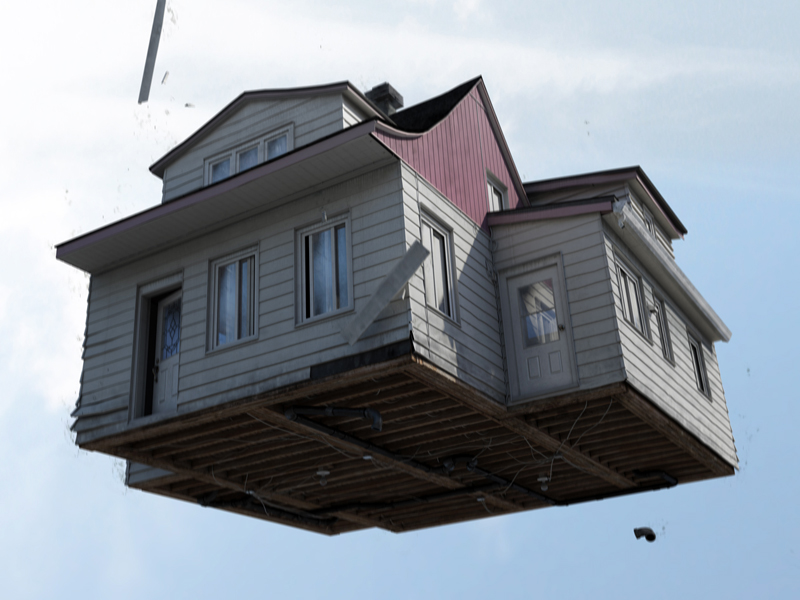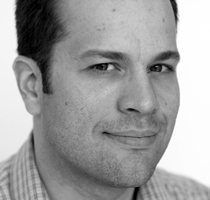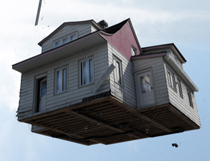Falls and Swoops
Patrick Iberi in conversation with Gwenaël Bélanger (interview was translated both ways, French/English, by Susie Veroff)
Patrick Iberi: It’s my pleasure to welcome you to issue 10 of MTLS. I’d like to begin with a request for you to shed some light on the entrapped images in your Chutes (Falls) collection. The common feature of this body of work is the uniformity of various objects photographed in free-fall. What’s the idea behind this?
Gwenaël Bélanger: My first series of Chutes (Falls) was made in 2002 and it is really the piece of work that launched my career. It was at the event ART MAKES BOOM! This is an important event in Montréal for young artists and I had just finished my Bachelor of Fine Arts at the University of Québec in Montréal. The Chutes series begins with the simple idea of photographing an object falling freely, a split second before it impacts the ground. The photographic medium specifically works to help us seize a moment that is difficult to perceive with the naked eye and can produce striking images. The image taken in full motion allows us to see invisible details, as Eadweard James Muybridge did with Cheval en mouvement (Horse in motion) (1878) and Etienne-Jules Marey with Étude de la course du cheval (The study of the horse race) (1886) respectively by breaking down the movement of a galloping horse. Like “teaser†advertising, image fixing like this causes a movement that at first captures our interest and curiosity, and then poses a puzzle. What happens before and after the shot? For the viewer, Project Falls (2003) and The Great Jumble (2005) seem to create an involuntary tendency of anticipating and then prolonging the action in one’s virtual and off-field imagination. I must also say that I’m interested in what is known, that is, what we know and recognize, what is common, ordinary, and usual. I call this everyday reality. Everyday life is made up of things we experience every day and do not notice and is also often a repetition of actions, and unimportant gestures. It is often said that this is the normal state of affairs, that which is usual, customary and common. I am not particularly interested in my daily life and I do not base my inspiration only on my personal history. I wonder more about what seems obvious – things whose origin we have forgotten. The term “infra-ordinary,†borrowed from Georges Perec, could well describe the type of day that I am interested in questioning. Everyday life is not trivial, but it can become so depending on the opinion we have of it. I hope to validate this rather than make trivial by carefully observing the complex mental games of perception we play that convert the everyday into the ordinary, the boring or the unexpected. I put an ordinary object in a situation that is not trivial. This action then demands to be looked at from another point of view, and that creates a shift in perception. I have always being fascinated by the different games of perception, such as trompe l’oeil, or anamorphic and optical illusions. I also have this habit of scrutinizing objects, trying to understand the mechanism at work. It was while doing my Master’s degree that I started to really identify the question of the image as an important part of my creation. This appetite for the effects of representation and image guided me in the past to graphic design in an attempt to understand the workings of the creation of images better. It is also this passion that drove me to create my first photographic project, Falls (2002), in which I adopt this medium, allowing me to find answers to many questions and to make visual the dimensions of my research.
P.I.: Your portfolio is dominated by initiatives centred on the mutability and perpetual movement of objects; an example is the Courir les rues (Running in the streets) project where you wandered through the city to capture elements overlooked by the urban dweller. What was the biggest test in scrutinising those images with your lens?
G.B.: The project Courir les rues (Running in the streets) (2005) came from a commonplace observation that had captivated me since childhood – that is, the perspective of a passenger looking outside from a moving vehicle. The passing scenery parallel to the road is fascinating. The challenge is to catch everything, the eye not knowing what to fixate on. The elements in the background do not scroll at the same speed as those in the foreground, and are in focus. Ed Ruscha with Every Building on the Sunset Strip (1966) and Stan Douglas with Every Building on 100 West Hastings (2001) attempted to propose a similarly impossible perspective by showing what lies beyond our field of vision and representing, in a single plane, a complete street. In my own way, I wanted to explore the space-time dimension of the movement that we feel in a moving vehicle in order to materialize this visual experience, which could be considered banal. I fixed my movements in time-space using a cinematographically transformed 35 mm camera with a motor to shoot five frames per second in a moving car. This resulted in long horizontal photographs created by the merging of the images taken by the camera during the ride. They show not only a technically impossible panorama, but also the distance from one point to another. The photographic trace produced by the shutter speed recreates the effect of apparent motion observed with the naked eye. That which scrolls close to us moves faster and is more difficult to perceive. In fact, our retinal perception is misleading, it is the sense of dynamic depth that informs us about the space we travel in.
















No Comments so far ↓
There are no comments yet...Kick things off by filling out the form below.